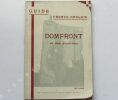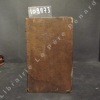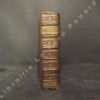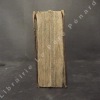-
Latest
Last 24h (100)
Last 3 days (46)
Last month (3080)
Last week (154)
-
Century
16th (240)
17th (986)
18th (4265)
19th (24052)
20th (84748)
21st (10211)
lrb.search.century.FOURTEEN (1)
-
Countries
Belgium (27213)
Brazil (1)
Canada (502)
China (23)
Côte d'Ivoire (323)
Denmark (2009)
France (163118)
Germany (612)
Greece (68)
Italy (7)
Netherlands (1651)
Switzerland (16262)
-
Syndicate
ALAC (498)
CLAM (134)
CLAQ (446)
CNE (32)
ILAB (97846)
NVVA (5652)
SLACES (5477)
SLAM (88366)
SNCAO (27)
Discours véritable et divers Prodiges arrivez en la Ville d'Angers Comme tremblement de terre, signes tres horribles, bentes en l'air, tempeste impetueuse et de la Furieuse Fontaine qu'on appelle la Fontaine Godeline [ Exemplaire sur peau de vélin ]
1 brochure in-12 sur peau de vélin monté sous deux couvertures postérieures de carton souple, Jouxte la Copie Imprimée, à Paris, 1609, [ Imprimerie Louis Perrin, 1874, Lyon ], 11 pp. et 2 ff. n. ch.. Rappel du titre complet : Discours véritable et divers Prodiges arrivez en la Ville d'Angers Comme tremblement de terre, signes tres horribles, bentes en l'air, tempeste impetueuse et de la Furieuse Fontaine qu'on appelle la Fontaine Godeline [ Exemplaire sur peau de vélin ]
Exceptionnel exemplaire imprimé sur peau de vélin, tirage très probablement unique. Cette remarquable impression sur les presses de Louis Perrin fait partie d'une série de réimpression d'au moins dix plaquettes des seizième et dix-septième consacrés à des manifestations merveilleuses ou étranges divers 10 villes de France. Caillet, 3163 (qui le cite, manifestement sans l'avoir vu caril indique une date approximative). On trouve un exemplaire sur peau de vélin (peut-être le même) au numéro 1210 sur catalogue de la bibliothèque du grand bibliophile Emile Desmazières (grand collectionneur d'exemplaires sur peau de vélin).
Discours véritable et divers Prodiges arrivez en la Ville d'Angers Comme tremblement de terre, signes tres horribles, bentes en l'air, tempeste impetueuse et de la Furieuse Fontaine qu'on appelle la Fontaine Godeline
1 brochure in-8 sur papier vergé montée sous deux couvertures postérieures de carton souple, Jouxte la Copie Imprimée, à Paris, 1609, [ Imprimerie Louis Perrin, 1874, Lyon ], 11 pp. et 2 ff. n. ch.
Cette impression sur les presses de Louis Perrin fait partie d'une série de réimpression d'au moins dix plaquettes des seizième et dix-septième consacrés à des manifestations merveilleuses ou étranges divers 10 villes de France. Caillet, 3163 (qui le cite, manifestement sans l'avoir vu caril indique une date approximative).
DISCUSSION POLITIQUE sur la vénalité des charges et offices en France sur les avantages pour l'Etat et pour la société et sur les funéstes inconveniens de la suppression qui en a été decrétée par l'Assemblée nationale
1792 1792 CRAPART/SENNEVILLE /DUFRESNE etc 1792- IN8 br.38 p.couv.imp.
Remise de 20% pour toutes commandes supérieures à 200 €
Divisions historiques et chronologiques de l'Histoire Ancienne, pour en faciliter l'intelligence & la mémoire aux enfans. Suivi de "Examen du Discours qui a remporté le Prix de l'Académie Françoise, l'an 1760; ou Lettre à M. Thomas, Professeur au Collège de Beauvais.
Rouen, Imprimerie de Viret, 1759. In-12, plein veau époque, dos à nerfs orné de fleurons dorés, titre doré, toutes tranches rouges. Titre, 3 ff non chiffrés, 122 pp; 20 pp. Coupes et mors légèrement frottés, petite travail de ver sur le mors inférieur (sans gravité), quelques rousseurs.
Dix ans d'impérialisme
Dentu E. Broché 1863 In-8, (22x14 cm), broché, 292 pages, édition originale pour l'édition française, anonyme, rare ; manques et traces sur les plats et le dos, état correct. Livraison a domicile (La Poste) ou en Mondial Relay sur simple demande.
DOMFRONT et ses environs 1011 - 1608, Guide bilingue franco-anglais,
Domfront Mme Papillon 1930 1 12° Broché 105 Mme Papillon, libraire éditeur, Domfront, 1930. Un volume in 12° broché de 105 pages, illustrations intérieures, texte bilingue français et anglais, bon état. Poids avant emballage 85 gr, frais d'envoi colissimo 5
Remises possibles sur les achats en lot, achetez plusieurs objets à la fois ! Reçoit sur rendez-vous pour consultation des ouvrages.
Douze documents confidentiels
Encyclopédie politique française. Non daté. In-4. Broché. Bon état, Couv. convenable, Dos satisfaisant, Intérieur frais. 14 pages avec 12 reproductions de documents. Nombreux tracts politiques en supplément.. . . . Classification Dewey : 944-Histoire de France varia
"Collection ""Faits et documents"" Classification Dewey : 944-Histoire de France varia"
Du passé et de l'avenir de la France. Deuxième édition.
1871 Lyon, Lecoffre, 1871, in 8° broché, 171 pages ; non coupé.
...................... Photos sur demande ..........................


Phone number : 04 77 32 63 69
Déclaration civique et religieuse des prêtres non-assermentés, à tous les français
Paris, Laillet, sans date, vers 1791, plaquette broché in-8 de 8 pp., couverture muette de papier jaune, bon exemplaire.
Révolution - Prêtres réfractaires ...
Département de la Loire inférieure. Etat de la population de la Commune de Malville
La Galerie des Ancêtres Les Recensements de l'an IV Républicain Dos carré collé 2005 In-4, (21x30 cm), reliure type thèse (dos carré collé et rhodoïd), couverture illustrée, 39 pages, les recensements de l'an IV Républicain ; plats légèrement cornés, bon état. Livraison a domicile (La Poste) ou en Mondial Relay sur simple demande.
ECHO DU MONDE, Tomes 1, 2, et 3. - Panorama économique, historique et culturel de tous les pays hors l'Europe. Une documentation pour la promotion des relations internationales et d'une coopération universelle.
Editions Metz.. 1965. In-4. Relié toilé. Bon état, Couv. convenable, Dos satisfaisant, Intérieur frais. 359+374+392 pages. Illustré de nombreuses photos en noir et blanc. Frontispice illustré en couleurs pour chacun des trois volumes.. . . . Classification Dewey : 990-Histoire générale des autres pays
Classification Dewey : 990-Histoire générale des autres pays
Edit du Roi concernant la Noblesse de Provence donné à Versailles au mois d’Avril 1778.
Paris, Chez P.G. Simon, 1778. [2]ff. reliés en cartonnage marbré, étiquette de maroquin au dos (reliure moderne).
Intéressant édit visant l’interdiction de faire une «distinction entre les familles nobles de Provence sous prétexte de descendance ou alliance avec les Juifs, Sarrasins, Mahométans & autres infidèles». Est visé une «prétendue liste de familles imposées comme juives en 1510» auxquelles Louis XII imposa des taxes particulières. Payé 350 francs suisse en 1961!!! De la bibliothèque Henry J. Reynaud.
Education des jeunes gens, ou Devoirs des peres et meres à l'égard de leurs enfans
1795 Sans mention d'éditeur ou d'imprimeur - 1795 - In-12 (10x16cm environ), reliure pleine peau brune, 5 nerfs - Filets, fleurons et pièce de titre dorés au dos, tranches mouchetées - 680 pages - Quelques bandeaux
Assez bon état, reliure compacte et lisse malgré dos cassé (sans cassure à la reliure) entrainant le léger décallage d'un feuillet - Galeries de ver en bas de certaines pages, proche de la reliure - Auréole de mouillure clair sur la partie basse de l'ouvrage - Coins éraflés et légèrement écrasés - Manque de matière à la coiffe inférieure1
Elisabeth II .Reine d'Angleterre .
Broché - 27.5x26.5 - 104 pp - Numéro spécial PARIS -MATCH - Hors série juin 1953.
Eloge funèbre d’une matrone romaine (éloge dit de Turia). Texte établi, traduit et commenté par Marcel Durry. Deuxième tirage revu et corrigé par Serge Lancel. Collection des Universités de France, publiée sous le patronage de l’Association Guillaume Budé.
Paris, Société d’Edition Les Belles Lettres 1992, 200x130mm, XCVIII - 82pages, reliure cartonnage de l’éditeur. Nom du possesseur sur le bas de la page de garde supérieure, autrement bel exemplaire.
édition bilingue: français - latin, Pour un paiement via PayPal, veuillez nous en faire la demande et nous vous enverrons une facture PayPal
ENCYCLOPEDIE DU COSTUME
HACHETTE. sans date. In-12. Relié. Bon état, Couv. légèrement passée, Dos satisfaisant, Intérieur frais. 64 pages illustrées de nombreuses photographies en noir et blanc.. . . . Classification Dewey : 900-GEOGRAPHIE, HISTOIRE, SCIENCES AUXILIAIRES DE L'HISTOIRE
Classification Dewey : 900-GEOGRAPHIE, HISTOIRE, SCIENCES AUXILIAIRES DE L'HISTOIRE
ENCYCLOPEDIE PAR L'IMAGE - BALZAC
HACHETTE. 1950. In-12. Broché. Bon état, Couv. convenable, Dos abîmé, Intérieur frais. 64 pages illustrées de nombreuses photographies en noir et blanc. Couverture en couleurs.. . . . Classification Dewey : 900-GEOGRAPHIE, HISTOIRE, SCIENCES AUXILIAIRES DE L'HISTOIRE
Classification Dewey : 900-GEOGRAPHIE, HISTOIRE, SCIENCES AUXILIAIRES DE L'HISTOIRE
ENCYCLOPEDIE PAR L'IMAGE - GEOGRAPHIE DE LA FRANCE
HACHETTE. 1933. In-12. Broché. Bon état, Couv. légèrement passée, Dos frotté, Intérieur frais. 64 pages illustrées de nombreuses photographies en noir et blanc. Couverture en couleurs.. . . . Classification Dewey : 900-GEOGRAPHIE, HISTOIRE, SCIENCES AUXILIAIRES DE L'HISTOIRE
Classification Dewey : 900-GEOGRAPHIE, HISTOIRE, SCIENCES AUXILIAIRES DE L'HISTOIRE
ENCYCLOPEDIE PAR L'IMAGE - HENRI IV
HACHETTE. 1949. In-12. Broché. Bon état, Couv. convenable, Coiffe en pied abîmée, Intérieur frais. 64 pages illustrées de nombreuses photographies en noir et blanc. Couverture en couleurs.. . . . Classification Dewey : 900-GEOGRAPHIE, HISTOIRE, SCIENCES AUXILIAIRES DE L'HISTOIRE
Classification Dewey : 900-GEOGRAPHIE, HISTOIRE, SCIENCES AUXILIAIRES DE L'HISTOIRE
ENCYCLOPEDIE PAR L'IMAGE - HISTOIRE DE FRANCE
HACHETTE. 1926. In-12. Broché. Bon état, Couv. convenable, Dos satisfaisant, Intérieur frais. 64 pages illustrées de nombreuses photographies en noir et blanc. Couverture en couleurs.. . . . Classification Dewey : 900-GEOGRAPHIE, HISTOIRE, SCIENCES AUXILIAIRES DE L'HISTOIRE
Classification Dewey : 900-GEOGRAPHIE, HISTOIRE, SCIENCES AUXILIAIRES DE L'HISTOIRE
ENCYCLOPEDIE PAR L'IMAGE - HISTOIRE DE L'ART
HACHETTE. 1951. In-12. Broché. Bon état, Couv. convenable, Dos satisfaisant, Intérieur frais. 64 pages illustrées de nombreuses photographies en noir et blanc. Couverture en couleurs.. . . . Classification Dewey : 900-GEOGRAPHIE, HISTOIRE, SCIENCES AUXILIAIRES DE L'HISTOIRE
Classification Dewey : 900-GEOGRAPHIE, HISTOIRE, SCIENCES AUXILIAIRES DE L'HISTOIRE
ENCYCLOPEDIE PAR L'IMAGE - HISTOIRE GRECQUE
HACHETTE. 1952. In-12. Broché. Bon état, Couv. convenable, Dos satisfaisant, Intérieur frais. 64 pages illustrées de nombreuses photographies en noir et blanc. Couverture en couleurs.. . . . Classification Dewey : 900-GEOGRAPHIE, HISTOIRE, SCIENCES AUXILIAIRES DE L'HISTOIRE
Classification Dewey : 900-GEOGRAPHIE, HISTOIRE, SCIENCES AUXILIAIRES DE L'HISTOIRE
ENCYCLOPEDIE PAR L'IMAGE - HISTOIRE ROMAINE
HACHETTE. 1956. In-12. Broché. Bon état, Couv. convenable, Dos satisfaisant, Intérieur frais. 64 pages illustrées de nombreuses photographies en noir et blanc. Couverture en couleurs.. . . . Classification Dewey : 900-GEOGRAPHIE, HISTOIRE, SCIENCES AUXILIAIRES DE L'HISTOIRE
Classification Dewey : 900-GEOGRAPHIE, HISTOIRE, SCIENCES AUXILIAIRES DE L'HISTOIRE
ENCYCLOPEDIE PAR L'IMAGE - HISTOIRE SAINTE
HACHETTE. 1928. In-12. Broché. Bon état, Couv. défraîchie, Dos abîmé, Intérieur frais. 64 pages illustrées de nombreuses photographies en noir et blanc. Couverture en couleurs.. . . . Classification Dewey : 900-GEOGRAPHIE, HISTOIRE, SCIENCES AUXILIAIRES DE L'HISTOIRE
Classification Dewey : 900-GEOGRAPHIE, HISTOIRE, SCIENCES AUXILIAIRES DE L'HISTOIRE
ENCYCLOPEDIE PAR L'IMAGE - JEANNE D'ARC
HACHETTE. 1948. In-12. Broché. Bon état, Couv. légèrement pliée, Dos satisfaisant, Intérieur frais. 64 pages illustrées de nombreuses photographies en noir et blanc. Couverture en couleurs.. . . . Classification Dewey : 900-GEOGRAPHIE, HISTOIRE, SCIENCES AUXILIAIRES DE L'HISTOIRE
Classification Dewey : 900-GEOGRAPHIE, HISTOIRE, SCIENCES AUXILIAIRES DE L'HISTOIRE
 Write to the booksellers
Write to the booksellers





















